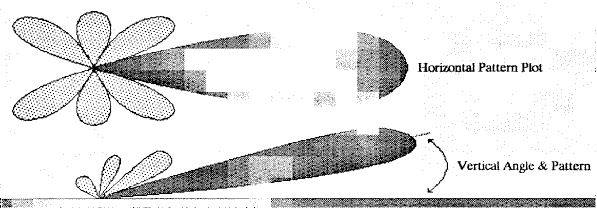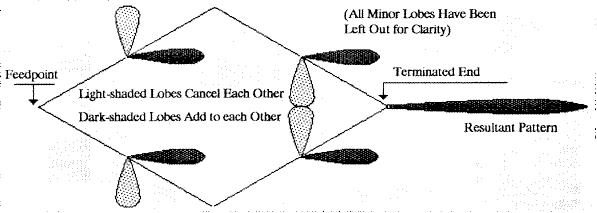Rhombic An Impressive Antenna
The rhombic is regarded by some as the highest development of the long wire antenna and if size is any indication of this, the rhombic is definitely king. Ranging from several hundred feet long to several thousand, there are no other HF antennas that will take up as much real estate as the rhombic. The heights of the supporting poles are anywhere from 60 to 200 feet tall depending on the frequency range that the antenna was designed for.
It used to be a joke on the ham bands that all anyone needed was a rotatable rhombic 10 wavelengths on a leg for 160 meters and there would be no DX competition for anyone with an antenna like that. Consider that a wavelength on 160 is 520 feet, and one leg of the rhombic would be 5200 feet long. It would be a HUGE antenna and have an enormous amount of gain. Figure 1 shows the basic rhombic configuration.

Basic Shape
The basic shape of a rhombic is that of a diamond. All sides of the antenna have the same lengths and the opposite comer angles are equal. If the end of the rhombic opposite the feed point is terminated with a noninductive resistor, the antenna then becomes a unidirectional antenna. In other words, the rhombic transmits and receives best in the direction of the termination resistor.
Maximum radiation does not occur in the plane of the antenna, but at some vertical angle determined by the length of the legs of the antenna and the height the antenna is suspended above ground.

Figure 2 illustrates the angle of radiation of the rhombic.
For Long Distance
The primary use of the rhombic is for long distance, fixed point to point communications, and is very popular for this type of communications. They are used widely for military, press and other long-range commercial circuits. By using a rhombic at both ends of the circuit, solid communications is almost guaranteed at all times depending on the frequency used. Many of the commercial and military antenna farms have rhombics pointed in as many directions as there are designated stations to contact.
Many Advantages
The advantages of the rhombic are many:
- It is useful over a large frequency range. A range of 2:1 is easily covered with excellent results. A frequency range of 4:1 can be worked by a’ typical rhombic with good results. Most standard rhombics can cover 5:1 or 6:1 as well. There will be some changes in directivity, gain and characteristic impedance but, not of any consequence.
- The rhombic is easier to construct and maintain than other antennas of comparable gain and directivity. It is supported by four poles ranging in heights from 50 to 200 feet tall depending on the frequency range. The average height for the HF range is about 90 feet. The antenna is usually made up of single wire elements, however; some rhombics are made using multiple wire elements.
- The rhombic is noncritical so far as operation and adjustment is concerned. This is due to the broadband characteristics of the antenna.
- The voltage present on the antenna is less than on another antenna with the same power input from the transmitter.
Disadvantages Too
Some main disadvantages of the rhombic are:
- A large amount of real estate is needed for the antenna. Each leg is made at least 1 to 2 wavelengths at its lowest operating frequency. When maximum gain and directivity is required, the leg lengths increase to 8 to 12 wavelengths. This means that HF rhombics must have leg lengths of several hundred feet.
- The horizontal and vertical patterns are dependent on each other. If a rhombic is made to have a narrow horizontal beamwidth then, the vertical pattern is also going to be lower and narrower. So, it is impossible to have a high vertical angle of radiation unless you have a wide horizontal pattern. This is not where the rhombic shines, since it is used for long distance sky-wave coverage at the higher frequencies.
In a terminated rhombic, some of the antenna input power is dissipated in the termination resistor, however; this resistor is required to make the rhombic unidirectional. The large amount of gain that a rhombic has makes up for what is lost in the termination resistor. The gain of a rhombic is a combination of the individual patterns of the individual legs and, if the tilt angle T is chosen correctly, then all of the shaded lobes will add together to form one extremely narrow major lobe with a really high gain. See Figure 3.

Feedpoint
Practically all rhombics are erected horizontally polarized and the feed-point is put at one end as shown in Figure 1. The feedpoint is a balanced connection. The feedline can either be open line or a coaxial cable and broad band balun combination. The gain and antenna pattern beamwidth are determined by the length of the legs, with the longer leg lengths giving the highest gain, narrower patterns and resulting lower angles of radiation.
Three Wire Legs
The rhombic can be erected as a three-wire per leg antenna in addition to the single wire antenna. The advantages of the three-wire version are slightly more gain, about one dB, and, a more constant impedance value over the designed frequency range. The feedpoint impedance also goes down somewhat, allowing a better impedance match to conventional 60(R)hm feed lines.
Non-Resonant Versus Resonant
So far, the rhombics discussed have been the non-resonant type that terminate at the end opposite the feed point. The resonant rhombics are a different antenna as far as operation is concerned. The physical appearance is the same except that the resistive termination at the end opposite the feedpoint is not used.
With the termination removed, the antenna then becomes a bi-directional antenna, with maximum radiation taking place along the major axis of the antenna. The input impedance then also changes, usually to a much higher value. As a result, the method of feeding the antenna changes, with either resonant feedlines or impedance matching sections being used. Because of this, the antenna cannot be used over a wide frequency range without extensive re-tuning of both the coupling system and the impedance sections.
Pattern Changes
The resonant rhombic is also subject to a certain amount of pattern changing when the frequency is shifted from the design center frequency. Moreover, the gain of the resonant rhombic is less than the non-resonant rhombic since the power is equally divided in two directions along the axis of the antenna. This can cause interference to other stations outside of the communications circuit. It is unlikely many of us will ever get the chance to put up a rhombic antenna due to size and cost. But, the rhombic remains an important part of the communications world today and really makes interesting reading for those who enjoy antennas.
Moon Bouncing
Several hams have put up two meter rhombics and used them for moon-bounce with excellent results. Of course, they only work for part of the year when the moon is in the antenna’s pattern as the earth rotates through its seasonal cycles.
Originally posted on the AntennaX Online Magazine by Richard Morrow, K5CNF
Last Updated : 25th April 2024
